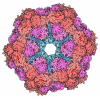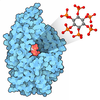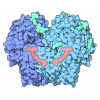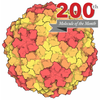+ Open data
Open data
- Basic information
Basic information
| Entry | Database: PDB / ID: 9e9z | ||||||||||||||||||||||||
|---|---|---|---|---|---|---|---|---|---|---|---|---|---|---|---|---|---|---|---|---|---|---|---|---|---|
| Title | SINV-WEEV Fleming in complex with VLDLR LA(1-2) | ||||||||||||||||||||||||
 Components Components |
| ||||||||||||||||||||||||
 Keywords Keywords | VIRAL PROTEIN / Alphavirus Receptor / VIRUS | ||||||||||||||||||||||||
| Function / homology |  Function and homology information Function and homology informationreelin receptor activity / VLDL clearance / glycoprotein transport / very-low-density lipoprotein particle receptor activity / ventral spinal cord development / Reelin signalling pathway / very-low-density lipoprotein particle binding / low-density lipoprotein particle receptor activity / very-low-density lipoprotein particle clearance / togavirin ...reelin receptor activity / VLDL clearance / glycoprotein transport / very-low-density lipoprotein particle receptor activity / ventral spinal cord development / Reelin signalling pathway / very-low-density lipoprotein particle binding / low-density lipoprotein particle receptor activity / very-low-density lipoprotein particle clearance / togavirin / reelin-mediated signaling pathway / very-low-density lipoprotein particle / positive regulation of dendrite development / cargo receptor activity / T=4 icosahedral viral capsid / lipid transport / dendrite morphogenesis / regulation of synapse assembly / apolipoprotein binding / cholesterol metabolic process / clathrin-coated pit / receptor-mediated endocytosis / VLDLR internalisation and degradation / memory / calcium-dependent protein binding / nervous system development / symbiont-mediated suppression of host toll-like receptor signaling pathway / host cell cytoplasm / receptor complex / symbiont-mediated suppression of host gene expression / lysosomal membrane / serine-type endopeptidase activity / fusion of virus membrane with host endosome membrane / calcium ion binding / symbiont entry into host cell / virion attachment to host cell / host cell nucleus / host cell plasma membrane / glutamatergic synapse / virion membrane / structural molecule activity / signal transduction / proteolysis / RNA binding / membrane / plasma membrane Similarity search - Function | ||||||||||||||||||||||||
| Biological species |  Western equine encephalitis virus Western equine encephalitis virus Homo sapiens (human) Homo sapiens (human) | ||||||||||||||||||||||||
| Method | ELECTRON MICROSCOPY / single particle reconstruction / cryo EM / Resolution: 3.95 Å | ||||||||||||||||||||||||
 Authors Authors | Raju, S. / Diamond, M.S. / Fremont, D.H. / Center for Structural Biology of Infectious Diseases (CSBID) | ||||||||||||||||||||||||
| Funding support |  United States, 1items United States, 1items
| ||||||||||||||||||||||||
 Citation Citation |  Journal: Cell / Year: 2025 Journal: Cell / Year: 2025Title: Structural basis for plasticity in receptor engagement by an encephalitic alphavirus. Authors: Saravanan Raju / Sathvik Palakurty / Alan Sariol / Ngan Wagoner / Lucas J Adams / Sean Hui / William B Klimstra / Daved H Fremont / Michael S Diamond /  Abstract: The structural basis for shifts in receptor usage remains poorly understood despite the implications for virus adaptation and emergence. Western equine encephalitis virus (WEEV) strains exhibit ...The structural basis for shifts in receptor usage remains poorly understood despite the implications for virus adaptation and emergence. Western equine encephalitis virus (WEEV) strains exhibit different patterns of engagement for two of their entry receptors: very-low-density lipoprotein receptor (VLDLR) and protocadherin 10 (PCDH10). Using structural and functional studies, we show that while all WEEV strains have a lipoprotein class A (LA) domain binding site near the E1 fusion loop, VLDLR engagement requires a second binding site in E2 that can vary with single nucleotide substitutions. We also resolve a structure of PCDH10 bound to WEEV, which reveals interactions near the E1 fusion loop with residues that also mediate LA domain binding. Evolutionary analysis enabled the generation of a PCDH10 decoy that protects in vivo against all WEEV strains tested. Our experiments demonstrate how viruses can engage multiple receptors using shared determinants, which likely impacts cellular tropism and virulence. | ||||||||||||||||||||||||
| History |
|
- Structure visualization
Structure visualization
| Structure viewer | Molecule:  Molmil Molmil Jmol/JSmol Jmol/JSmol |
|---|
- Downloads & links
Downloads & links
- Download
Download
| PDBx/mmCIF format |  9e9z.cif.gz 9e9z.cif.gz | 726 KB | Display |  PDBx/mmCIF format PDBx/mmCIF format |
|---|---|---|---|---|
| PDB format |  pdb9e9z.ent.gz pdb9e9z.ent.gz | 594.4 KB | Display |  PDB format PDB format |
| PDBx/mmJSON format |  9e9z.json.gz 9e9z.json.gz | Tree view |  PDBx/mmJSON format PDBx/mmJSON format | |
| Others |  Other downloads Other downloads |
-Validation report
| Arichive directory |  https://data.pdbj.org/pub/pdb/validation_reports/e9/9e9z https://data.pdbj.org/pub/pdb/validation_reports/e9/9e9z ftp://data.pdbj.org/pub/pdb/validation_reports/e9/9e9z ftp://data.pdbj.org/pub/pdb/validation_reports/e9/9e9z | HTTPS FTP |
|---|
-Related structure data
| Related structure data |  47822MC  9e96C  9e9yC  9eauC M: map data used to model this data C: citing same article ( |
|---|---|
| Similar structure data | Similarity search - Function & homology  F&H Search F&H Search |
- Links
Links
- Assembly
Assembly
| Deposited unit | 
|
|---|---|
| 1 |
|
- Components
Components
| #1: Protein | Mass: 47314.727 Da / Num. of mol.: 4 Source method: isolated from a genetically manipulated source Source: (gene. exp.)  Western equine encephalitis virus / Strain: Fleming / Cell line (production host): BHK21 / Production host: Western equine encephalitis virus / Strain: Fleming / Cell line (production host): BHK21 / Production host:  Mesocricetus auratus (golden hamster) / References: UniProt: A0A5J6NBQ1 Mesocricetus auratus (golden hamster) / References: UniProt: A0A5J6NBQ1#2: Protein | Mass: 45368.840 Da / Num. of mol.: 4 Source method: isolated from a genetically manipulated source Source: (gene. exp.)  Western equine encephalitis virus / Strain: Fleming / Cell line (production host): BHK21 / Production host: Western equine encephalitis virus / Strain: Fleming / Cell line (production host): BHK21 / Production host:  Mesocricetus auratus (golden hamster) / References: UniProt: A0A5J6NBQ1 Mesocricetus auratus (golden hamster) / References: UniProt: A0A5J6NBQ1#3: Protein | Mass: 16712.816 Da / Num. of mol.: 4 Source method: isolated from a genetically manipulated source Source: (gene. exp.)  Western equine encephalitis virus / Cell line (production host): BHK21 / Production host: Western equine encephalitis virus / Cell line (production host): BHK21 / Production host:  Mesocricetus auratus (golden hamster) / References: UniProt: P13897, togavirin Mesocricetus auratus (golden hamster) / References: UniProt: P13897, togavirin#4: Protein | Mass: 8585.350 Da / Num. of mol.: 4 / Fragment: UNP residues 31-108 Source method: isolated from a genetically manipulated source Source: (gene. exp.)  Homo sapiens (human) / Gene: VLDLR / Cell line (production host): Expi293 / Production host: Homo sapiens (human) / Gene: VLDLR / Cell line (production host): Expi293 / Production host:  Homo sapiens (human) / References: UniProt: P98155 Homo sapiens (human) / References: UniProt: P98155#5: Chemical | ChemComp-CA / Has ligand of interest | Y | Has protein modification | Y | |
|---|
-Experimental details
-Experiment
| Experiment | Method: ELECTRON MICROSCOPY |
|---|---|
| EM experiment | Aggregation state: PARTICLE / 3D reconstruction method: single particle reconstruction |
- Sample preparation
Sample preparation
| Component | Name: Western equine encephalitis virus / Type: VIRUS Details: A chimeric virus comprised of Sindbis non-structural genes and the structural genes of WEEV Fleming was generated. Virus was grown in BHK21 cells and purified form the supernant. Entity ID: #1-#4 / Source: MULTIPLE SOURCES |
|---|---|
| Source (natural) | Organism:  Western equine encephalitis virus Western equine encephalitis virus |
| Source (recombinant) | Organism:  Mesocricetus auratus (golden hamster) / Cell: BHK21 Mesocricetus auratus (golden hamster) / Cell: BHK21 |
| Details of virus | Empty: NO / Enveloped: YES / Isolate: STRAIN / Type: VIRION |
| Buffer solution | pH: 7.4 |
| Specimen | Embedding applied: NO / Shadowing applied: NO / Staining applied: NO / Vitrification applied: YES |
| Vitrification | Cryogen name: ETHANE |
- Electron microscopy imaging
Electron microscopy imaging
| Experimental equipment |  Model: Titan Krios / Image courtesy: FEI Company |
|---|---|
| Microscopy | Model: TFS KRIOS |
| Electron gun | Electron source:  FIELD EMISSION GUN / Accelerating voltage: 300 kV / Illumination mode: FLOOD BEAM FIELD EMISSION GUN / Accelerating voltage: 300 kV / Illumination mode: FLOOD BEAM |
| Electron lens | Mode: BRIGHT FIELD / Nominal defocus max: 2200 nm / Nominal defocus min: 700 nm |
| Image recording | Electron dose: 47 e/Å2 / Film or detector model: FEI FALCON IV (4k x 4k) |
- Processing
Processing
| EM software | Name: PHENIX / Category: model refinement |
|---|---|
| CTF correction | Type: PHASE FLIPPING AND AMPLITUDE CORRECTION |
| 3D reconstruction | Resolution: 3.95 Å / Resolution method: FSC 0.143 CUT-OFF / Num. of particles: 147247 / Symmetry type: POINT |
| Refinement | Highest resolution: 3.95 Å Stereochemistry target values: REAL-SPACE (WEIGHTED MAP SUM AT ATOM CENTERS) |
 Movie
Movie Controller
Controller









 PDBj
PDBj











